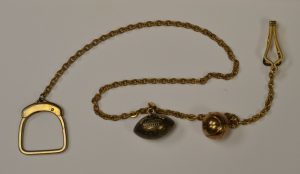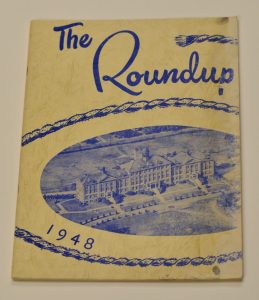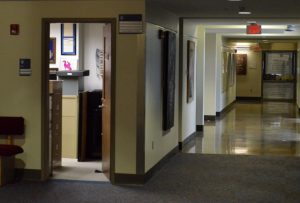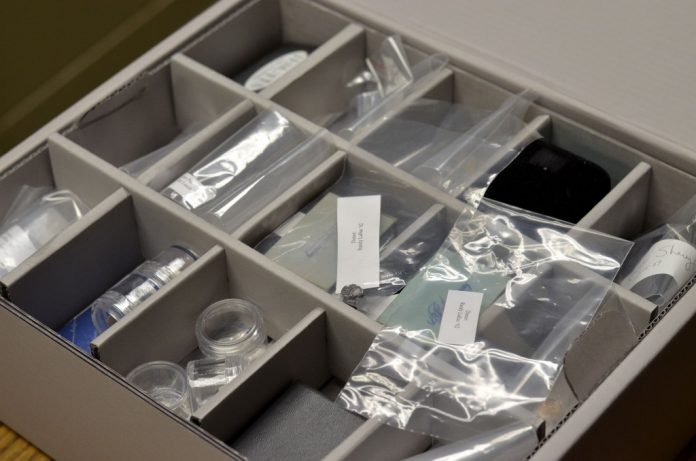Similarly to The Chronicles of Narnia, a small room in Jesuit leads the onlooker to an alternate reality. The Jesuit Archives, a small room piled high with aged photographs, colorful memorabilia and books from years past, is located across from the Jesuits’ Rectory. Records go back to the late 1930s when the Jesuits petitioned Rome for permission to begin a school in Dallas.
 Several volunteers–Mrs. Ellen Grimes, Joe Dillon, and Fr. Joseph Rivoire–contributed items for the 50th anniversary of the school; however, preservation and display of these artifacts began several years ago. For six years now, Ms. Sheryl Row has maintained the Archives by collecting, organizing, preserving, and communicating to others the history of the school.
Several volunteers–Mrs. Ellen Grimes, Joe Dillon, and Fr. Joseph Rivoire–contributed items for the 50th anniversary of the school; however, preservation and display of these artifacts began several years ago. For six years now, Ms. Sheryl Row has maintained the Archives by collecting, organizing, preserving, and communicating to others the history of the school.
Scrapbooks, diaries, newspapers, photographs, and letters trace the school’s development. Ms. Row says about her years of working in that closet of a room, “The documents back there have told me quite a bit about the history of the school that I did not know, even though I have worked here since 1979.”
Principal Mr. Tom Garrison, in referencing the most recent Jesuit Today noted, “The Archives are an elaboration of 70 years and stitch together the past with the present. I hope that the students, in having some of these things that bring the past into the present, recognize our places at school.”
 1955 brought a major change to Jesuit as it became the first school in Dallas to integrate. “One benefit of my working in the archives,” Ms. Row notes, “is that in ’05 I got to wondering about Charles Edmond, the first black graduate from Jesuit Dallas. We knew Arthur Allen (the other black student at Jesuit in 1955) well, because he had remained involved in the school, donating time and resources and becoming one of our Distinguished Alums.”
1955 brought a major change to Jesuit as it became the first school in Dallas to integrate. “One benefit of my working in the archives,” Ms. Row notes, “is that in ’05 I got to wondering about Charles Edmond, the first black graduate from Jesuit Dallas. We knew Arthur Allen (the other black student at Jesuit in 1955) well, because he had remained involved in the school, donating time and resources and becoming one of our Distinguished Alums.”
“Allen was the second black graduate, and Charles was a year ahead of him. I found Charles in St. Louis. He and I talked on the phone and we corresponded. After laying some groundwork, we were able to coax him to come to Jesuit last spring for a visit, his first return visit, while The Roundup was covering the school’s integration history. The Dallas Morning News covered Charles’ visit, helping educate greater Dallas to this historic event.”
Mr. David Berend, chief financial officer, noted, “I am not entirely sure how I came to be in charge of the Archives but I decided that its current location would be the best place. Ms. Row has helped in numerous volunteer ways and studied the strategies and ways to organize the archives. She has identified and labeled hundreds of pictures, even scanning them into the computer electronically, bringing the past into the present.”
One of Ms. Row’s most daunting tasks was sorting over a thousand loose, unlabeled slides.
 Numerous historical displays have been added around campus in the last few years. “They take a lot of time to create because it takes a while to do the research and to get the pertinent information gathered together that people might be interested in seeing,” Ms. Row explained.
Numerous historical displays have been added around campus in the last few years. “They take a lot of time to create because it takes a while to do the research and to get the pertinent information gathered together that people might be interested in seeing,” Ms. Row explained.
All of the current displays are located in the counseling area on the second floor above Hughes Hall. The current displays are of baseball, football, and cheer-leading in the 1940s and 50s. Senior activities are highlighted in Mr. Jack Fitzsimmons office commons. Ms. Row also hopes to add to the theater display next year, among others.
Occasionally, miscellaneous artifacts appear in Ms. Row’s mailbox, such as two dusty bricks from the Oak Lawn Building. These bricks, donated by the Donald Flusche, Sr. ’45 family, which she hopes to incorporate in a display. According to Berend, “Ms. Row is interested in obtaining such artifacts as class rings, theater props, uniforms, game balls, ticket stubs, programs, pictures and such from the past.”
 President Mr. Michael Earsing said that “the exhibits are a great way to see the traditions at Jesuit as there is always a connection between people, and it is a positive thing for us to experience. There is really no difference between the current guys here in comparison to the guys who graduated in the 80’s. The traditions that exist today existed then as well. It is like looking at a bunch of family photos. For me, it is fun that I see you guys and I can close my eyes and see your dad running around the campus. The reality is that you and he have something in common. You have the same goals and worries, and homework, for that matter. It’s almost as if having 10,000 sons go through the school,” he concluded.
President Mr. Michael Earsing said that “the exhibits are a great way to see the traditions at Jesuit as there is always a connection between people, and it is a positive thing for us to experience. There is really no difference between the current guys here in comparison to the guys who graduated in the 80’s. The traditions that exist today existed then as well. It is like looking at a bunch of family photos. For me, it is fun that I see you guys and I can close my eyes and see your dad running around the campus. The reality is that you and he have something in common. You have the same goals and worries, and homework, for that matter. It’s almost as if having 10,000 sons go through the school,” he concluded.
If you would like to see some of these displays, learn more about Jesuit’s history in sports and activities, read personal stories about what life was like at Jesuit in the old days, visit the Jesuit Dallas Archives blog at http://archives.jesuitroundup.org. You can also access the blog through Facebook and Jesuit’s home page.
Although Ms. Row laughs that “some people would say [she] is not organized,” she has arranged the archives by date as well as topic, such as Jesuits, faculty, alumni, and students. The students, for example, are subdivided into athletics and extracurricular activities, every club and sport respectively since 1942.
Row has also had some extra help along the way. “Two current students, Nick Rodriguez ’13 and Matthew Megarity ’16, have been working with me after school. Ms. Joan Degen volunteers and Cheryl Kluft organized the history of the JWA.
The multitude of papers and artifacts located in the Archives is pretty amazing, regardless if you are a history aficionado or not, as the row of cabinets and shelving seems to extend endlessly into the distance. In addition, everything in the Archives has a fascinating story behind it that contributes to the wonderful history of Jesuit.
For instance, “at one point,” said Mr. Berend, “Ms. Row took some autographed photos for appraisal. One was signed by First Lady Nancy Reagan, one by President Lyndon Johnson.”
Ms. Row’s favorite pieces of memorabilia include items from her first display, the cheerleader display. In fact, when Tim Heraty ’51 donated a well used megaphone Row decided to begin displaying items.
Another of her favorite things are a pair of 1940s baseball shoes. She likes the story behind them, that one young man who enlisted in WWII passed his shoes on to the next generation of students.
Few words can describe the amazing job Ms. Row has done in managing the Archives, but who is she as a person?
Ms. Sheryl Row, born in west Texas, moved to Dallas at six months of age. She grew up in the Lake Highlands area. In college she studied political science. “I thought I would work in city government, but I am too outspoken for politics.” She has a Masters in Special Education and a Masters in English.”
 She learned early to keep moving forward. “I have always had the attitude that even if something is hard to do, I have to find a way to get it done. That when I fail, I can succeed some where else. It’s a philosophy I taught my two daughters and that I hope for my students.”
She learned early to keep moving forward. “I have always had the attitude that even if something is hard to do, I have to find a way to get it done. That when I fail, I can succeed some where else. It’s a philosophy I taught my two daughters and that I hope for my students.”
Ms. Row also has two granddaughters and a near perfect son-in-law. She reads voraciously, travels widely, and works in several community service areas. “I am very committed to the Dallas Children’s Advocacy Center which helps abused, neglected, and exploited children. It’s where my heart is.”






